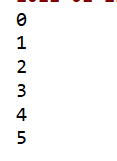Tensorflow基本概念
- 使用图(graphs)来表示计算任务
- 在被称之为会话(Session)的上下文(context)中执行图
- 使用tensor表示数据
- 通过变量(Variable)维护状态
- 使用feed和fetch可以为任意的操作赋值或者从其中获取数据
Tensorflow是一个编程系统,使用图(graphs)来表示计算任务,图(graphs)中的节点称之为op
(operation),一个op获得0个或多个Tensor,执行计算,产生0个或多个Tensor。Tensor 看作是
一个 n 维的数组或列表。图必须在会话(Session)里被启动。
Tensorflow结构

创建图,启动图
#2-1 创建图,启动图
#创建一个常量op
m1=tf.constant([[3,3]])
#创建一个常量op
m2=tf.constant([[2],[3]])
#创建一个矩阵乘法op
product=tf.matmul(m1,m2)
print(product)
with tf.compat.v1.Session() as sess:
# run(product)触发了图中的3个op
result = sess.run(product)
print(result)
结果为:

变量
#2-2变量
#创建一个变量初始化0
state=tf.Variable(0,name='counter')
#创建op,作用是使state加1
new_value=tf.add(state,1)
#赋值op
update=tf.compat.v1.assign(state,new_value)
with tf.compat.v1.Session() as sess:
#变量初始化
sess.run(tf.compat.v1.global_variables_initializer())
print(sess.run(state))
for _ in range(5):
sess.run(update)
print(sess.run(state))
输出为:

Fetch and Feed
#2-3Fetch and Feed
#Fetch
input1=tf.constant(3.0)
input2=tf.constant(2.0)
input3=tf.constant(5.0)
add=tf.add(input2,input3)
mul=tf.multiply(input1,add)
with tf.compat.v1.Session() as sess:
result=sess.run([mul,add])
print(result)
#Feed
#创建占位符
input1=tf.compat.v1.placeholder(tf.float32)
input2=tf.compat.v1.placeholder(tf.float32)
output=tf.multiply(input1,input2)
with tf.compat.v1.Session() as sess:
#feed的数据以字典传入
print(sess.run(output,feed_dict={input1:[7.],input2:[2.]}))
输出为:

线性模型
import numpy as np
#使用np生成100个随机点
x_data=np.random.rand(100)
y_data=x_data*0.1+0.2
#构造一个线性模型
b=tf.Variable(0.)
k=tf.Variable(0.)
y=k*x_data+b
#二次代价函数
loss=tf.reduce_mean(tf.square(y_data-y))
#定义一个梯度下降法来进行训练的优化器
optimizer=tf.compat.v1.train.GradientDescentOptimizer(0.2)
#最小化代价函数
train=optimizer.minimize(loss)
#对变量进行初始化
init=tf.compat.v1.global_variables_initializer()
with tf.compat.v1.Session() as sess:
sess.run(init)
for step in range(201):
sess.run(train)
if step%20==0:
print(step,sess.run([k,b]))
输出为:
